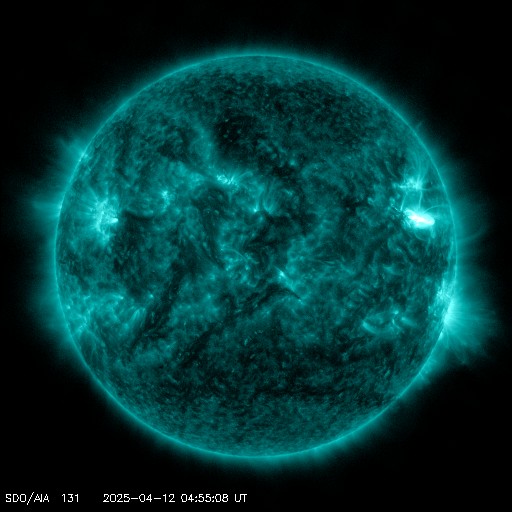Het archief bekijken van zaterdag 1 februari 2003
Activiteitenrapport
Bij elke genoemde zonnevlam in dit rapport werd een schaalfactor toegepast door het Space Weather Prediction Center (SWPC). Vanwege de SWPC-schaalfactor worden zonnevlammen 42% kleiner gerapporteerd dan voor de wetenschappelijke data. De schaalfactor werd verwijderd uit onze gearchiveerde zonnevlamdata om de werkelijke fysieke eenheden weer te geven.
Rapport van de zonne- en geofysische activiteit van 2003 Feb 01 2200 UTCOpgemaakt door de NOAA © SWPC en verwerkt door Poollicht.be
USAF/NOAA rapport van de zonneactiviteit en geofysische activiteit
SDF Nummer 032 gepubliceerd omstreeks 2200Z op 01 Feb 2003IA. Analyse van de actieve zonneregio's en zonneactiviteit van 31-2100Z tot 01-2100Z
Solar activity was moderate during the past 24 hours.
All of today's flare activity was dominated by new Region 276
(S14E76), which produced an M1 at 0905 UTC, a C9/Sf at 1954 UTC, as
well as numerous additional C-class subflares. Observations of the
group so far indicate a relatively small (190 millionths) D-type
sunspot group. An erupting prominence was observed at 31/2200 UTC on
the Northwest limb and was associated with a type II sweep (shock
velocity 500 km/s) and a CME seen by LASCO. The remainder of the
regions on the disk were quiet and stable.
IB. Voorspelling zonneactiviteit
Solar activity is expected to be low
to moderate. Region 276 is expected to be the main driver of
activity, and has a fair chance for producing an additional M-class
event over the next three days.
IIA. Samenvatting geofysische activiteit 31-2100Z tot 01-2100Z
The geomagnetic field ranged from quiet to active levels during the
past 24 hours. Quiet conditions prevailed for most of the day, but
an increase to unsettled to active began at 1500 UTC. A marked
increase in solar wind velocity and total magnetic field strength
was observed beginning at 1300 UTC, but a predominantly positive
value for Bz suppressed activity until 1900 UTC, when Bz turned
weakly southwards. The interpretation of the enhanced solar wind
flow is not obvious, but seems most consistent with the passage of
transient flow due to the halo CME that occurred on 30 January. The
great than 2 MeV electron fluxes reached high levels during the past
24 hours.
IIB. Voorspelling geofysische activiteit
The geomagnetic field is
expected to be mostly active for the next 24 hours with a chance for
some isolated minor storm periods. Conditions should subside to
unsettled to active by day two, and return to mostly unsettled
levels by the third day.
III. Kans zonnevlammen van 02 Feb tot 04 Feb
| Klasse M | 35% | 35% | 35% |
| Klasse X | 05% | 05% | 05% |
| Proton | 01% | 01% | 01% |
| PCAF | green | ||
IV. Penticton 10.7 cm Flux
Geobserveerd 01 Feb 126 Voorspeld 02 Feb-04 Feb 130/135/140 90 dagen gemiddelde 01 Feb 156
V. Geomagnetische A index
Geobserveerd Afr/Ap 31 Jan 011/018 Geraamd Afr/Ap 01 Feb 012/015 Voorspeld Afr/Ap 02 Feb-04 Feb 025/025-015/020-010/015
VI. Kansen op geomagnetische activiteit van 02 Feb tot 04 Feb
| A. Gemiddelde breedtegraad | |||
|---|---|---|---|
| Actief | 35% | 30% | 25% |
| Kleine storm | 30% | 20% | 15% |
| Zware-ernstige stormcondities | 15% | 05% | 01% |
| B. Hoge breedtegraad | |||
|---|---|---|---|
| Actief | 35% | 35% | 20% |
| Kleine storm | 40% | 30% | 10% |
| Zware-ernstige stormcondities | 20% | 10% | 05% |
Alle tijden in UTC
<< Keer terug naar de dagelijkse overview pagina
Op basis van de huidige parameters is er nu geen kans op poollicht in België en Nederland
Op basis van de huidige parameters is er in de nabije toekomst een beperkte kans op poollicht op de volgende locaties van de hoge breedtegraad
Gillam, MB, Whitehorse, YT, Yellowknife, NTLaatste nieuws
Laatste forumberichten
Suggesties? 8Noorderlicht kans 6-1-2025 2Poollicht 1 januari 2025 2Naar Noorwegen in Maart? 3Noorderlicht kans 10/11-10-2024 56
Meer forumberichtenSteun Poollicht.be!
Om ook bereikbaar te blijven bij grote poollichtkansen hebben we een zware server nodig die alle bezoekers aankan. Doneer en steun dit project zodat we online blijven en je geen enkele poollichtkans mist!

Laatste alerts
05:51 UTC - Radio blackout
Kleine R1 radio blackout gedetecteerd (≥M1 - momenteel: M1.16)
05:03 UTC - Zonnevlam
Matige M1.19 zonnevlam
04:48 UTC - Radio blackout
Kleine R1 radio blackout gedetecteerd (≥M1 - momenteel: M1.17)
vrijdag 11 april 2025
22:39 UTC - Zonnevlam
Matige M1.05 zonnevlam
22:24 UTC - Hemisferisch vermogen
Het OVATION-model voorspelt dat het hemisferisch vermogen 50GW zal bereiken om 23:16 UTC
Ruimteweer feitjes
| Laatste X-klasse uitbarsting | 28/03/2025 | X1.1 |
| Laatste M-klasse uitbarsting | 11/04/2025 | M1.0 |
| Laatste geomagnetische storm | 06/04/2025 | Kp5 (G1) |
| Zonnevlekkenloze dagen | |
|---|---|
| Laatste zonnevlekkenloze dag | 08/06/2022 |
| Maandelijks gemiddeld zonnevlekkengetal | |
|---|---|
| maart 2025 | 134.2 -20.4 |
| april 2025 | 139.5 +5.3 |
| Afgelopen 30 dagen | 136.6 -3.5 |




